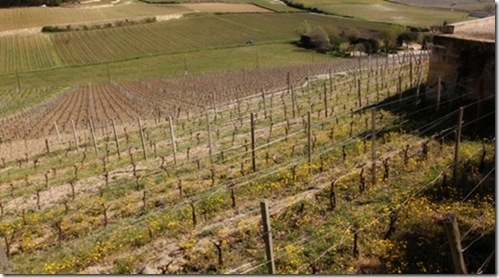
2012 was a challenging year for nearly everyone in Bordeaux. Some complained about the wet spring conditions that created irregular flowering and naturally low yields to start the season. This was followed by a cool month of May and a wet June with bouts of heavy rain that really harmed the critical flowering period. Grape bunches had uneven development and mildew began to spread if care was not taken in the vineyard. Then a dry early summer followed but without that much heat, just lack of rain, causing some vines to struggle. Usually a dry summer is desirable but after a very dry August, the vines started to struggle and suffer since there was no rain and suddenly at the end of August, the heat arrived.
The drought and heat conditions continued until nearly end of September and the white wines, which were picked before the 20th of September did very well. Starting towards the end of September, with the red grapes not yet harvested, the rains started to fall nearly continually, ranging from light to heavy downpours. For those who waited to harvest after October 17th, the grapes would have been through some very heavy rain. Looking at the rainfall patterns, April had some of the heaviest rain with over 150mm and October was not far behind with about 140mm. There were a few days of clear weather in between the rains and the timing of harvest was a gamble in 2012. At Chateau Pichon-Longueville, 2012 is known as the “vintage where we had to fight on all fronts.”
At Chateau Pichon Lalande, the 2012 is seen as a vintage with “alternating periods of cold and mild weather and generally very wet”. In the wines, the difference between the Grand Vin and the second wines are more extreme and the winemakers confirm that the older vines on the best terroir did much better in these challenging weather conditions than younger vines and vines in less favourable sites. At Lafite, the vintage is described as: “A difficult year, one which we would not like to see too often!” This meant work in the vineyard to keep botrytis at bay and even after the grapes were harvested, mostly in the rain for reds, high tech optical sorting equipment came in very handy.
Dry white wine producers were moderately happy, with many crafting refreshing, aromatic, medium bodied wines. Most of these grapes were harvested early and mid September and missed the heavy rains which came later. However, ripening was uneven so quality is variable. For many sweet wine producers, this was a disastrous year – top Sauternes producers like Yquem, Rieussec, Raymon Lafon, de Fargues and Suduiraut said they would not make any 2012s. Those who did choose to produce wine like Chateau Guiraud made only 700 cases which is less than 10% of their normal production. There were exceptions however, and producers like Climens, Coutet and Doisy Daene made very good sweet wines. Barsac in general did better than in Sauternes as a whole because their grape maturation cycle was more advanced and allowed them some protection against the late fall rains and challenging conditions.
In 2012, it was all about the combination of site, the unique development cycle of each variety and plot and how the challenging weather conditions affected the maturation process. As such, there was a lot of variation in maturation, within a vineyard as well as within each bunch of grapes! Selection, vigilance and preparation was key. At Pontet Canet, a third sorting line was added during harvest to quicken the pace of receiving the grapes from the vineyard during the rainy harvest period. Others resorted to advanced sorting machines or for sweet wine producers, cryoextraction, where grapes are frozen and the juice pressed to separate unwanted water thereby concentration flavours in the remaining juice.
At both Pontet Canet and Climens, where biodynamic methods are espoused, the proprietors were convinced that being biodynamic allowed them to produced good quality wine from grapes with thick skins that were able to survive the heavy rains and remain healthy until harvest. Others pointed to their unique plots or old vines where water stress during the summer months were not a problem, allowing ripening to occur before the heavy fall rains. Overall, the vintage is uneven with a wide variation in quality even within a single chateau. Two regions that were quite successful are Pomerol and Pessac-Leognan. Choose wisely and selectively in 2012 – there are some jewels to be found.









